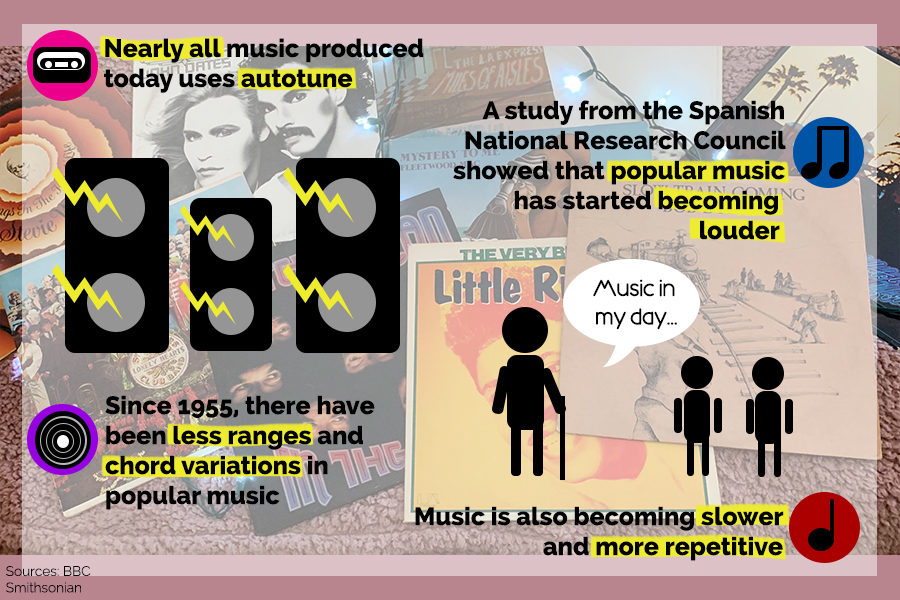Music industry stopped being creative a long time ago
Many people have long believed the music industry no longer produces unique sounds. Recently, studies determined that today’s music is repetitive and lacks differences in sounds.
April 2, 2019
It was only a few decades ago that the success of a song came from the response it got after being played on the radio and the sales it produced. That meant the music industry had to produce something new and exciting to compel audiences to purchase CDs or records.
With the introduction and diffusion of the internet, music sales began to decrease. From 1999 to 2011, the record industry shrunk by 64 percent, and the average amount of money a person in the U.S would spend on music decreased from $71 to $26. Music was just too convenient for the average listener.
“Back in the 60s and 70s, you didn’t have autotune or any of that technology that influences music, so you had to have that creative element,” Coppell High School history teacher Kyle Dutton said. “We listen to the same types of songs over and over, just like we read the same kinds of stories over and over.”
The music industry found itself having to shift gears in its money-making strategy.
For a song to become popular, the industry must rely heavily on the different ways consumers use the music, such as adding it to a playlist, sharing it with friends or using it in other projects that will come in contact with more people. A listener can listen to a song once and hate it, but repeated exposure to it has been proven to get consumers to like a song rather than writing one that will actually suit their tastes.
This is commonly known as brainwashing, and it gets more complicated from there.
You may think a song or genre is popular because you – the general public – have decided so, but you would be very wrong. A new track is sent out by artist managers, public relations firms and advertisers in a mailing list to hundreds of media outlets. They rely on brain tendencies, such as wanting to fit in, to essentially pressure audiences into supporting that track because it comes off as trendy, even though they may not like it at all.
Due to strategies used over the years to increase popularity, the music industry has also backed itself into a corner with the type of music it puts out. A study by the Spanish National Research Council (SNRC) took several hundreds of thousands of songs of all types of genres from 1955 to 2011 and ran them through an algorithm that compared them by their pitch, timbre and loudness.
Pitch content decreased, meaning musicians – or more accurately, their labels – have become acoustic wimps rather than adventurous risk-takers, producing predictable and, quite frankly boring music. This pattern caused the public’s ear to have an unconscious affinity toward the same chords, notes and beats. They begin to reject anything else, limiting the choices the music industry can make when they produce music.
The timbre, or richness of the song, has also reduced significantly throughout the years. Trending music is no longer “organic” and instead left to the capabilities of a machine, unlike several decades ago, when actual instruments and a voice which hits the intended notes rather than being masked over by a computer were used.
Music since the 1950s has also gotten much louder, which is bad news for the industry. The louder a song is, the less likely it will stand out in it. However, the SNRC has found the volume of music is increased by one decibel every eight years. This is largely due to the current generation’s choice.
As time passed and genres went in and out of fashion, those that were trendy during a certain period of time happened to be styles generally louder than their predecessors. Generations began preferring louder sounds, which was a demand the music industry continued to meet, even if it meant sacrificing originality and “texture” of songs.
“When the music industry didn’t have the technology to reach so many people around the world, the creators didn’t have a reason to make music solely for the money.” CHS junior Alex McCord said. “It would be passion-driven, which is why a lot of older music is so famed.”
The music industry has been so run dry of ideas that it has begun to blatantly use popular melodies from older musical pieces in current songs, such as “Centuries” by Fall Out Boy, which incorporated a recognizable tune from “Tom’s Diner” by Suzanne Vega, or “7 Rings” by Ariana Grande, which used a widely known phrase of the song “My Favorite Things” from The Sound of Music. This process, called sampling, has been around since the early 20th century. It was seen as uncommon and obscure. The difference between back then and today is that artists often do not acknowledge their use of sampling, and it can be found in the majority of songs being produced today. It is, in other words, glaringly uncreative.
As the music industry continues to scrape the barrel for musical and artistic expression, reality is almost all of the truly talented artists, musicians and bands out there will never get an opportunity to shine because it is simply too much of a gamble, too out of the blue and too original.











